The bird lake Tåkern is located in the southwest of Östergötland, directly east of the famous Omberg and Lake Vättern. It is one of Europe's most important breeding and resting places for many bird species. Up to 270 species were counted here, and about 120 species have their breeding places here. The Tåkern and its surroundings are designated as a nature reserve (54 km²) and are listed as a so-called Ramsar area according to the European Convention on Wetlands.
The lake is actually only a shallow water surface in the landscape, about 44 km² in size with an average depth of about 80 cm. Large reed beds surround the water. All in all, the Tåkern is Northern Europe's largest reed area with an area of 15,000 hectares. This leads to the fact that a large number of birds can be found here, which have their habitat in the reeds. The lake is surrounded by wet meadows and humid to wet shore forests. The wetlands can be kept open thanks to financial support for animal husbandry.
Lake Tåkern invites you to a visit both during the breeding season and at the time of bird migration. The best periods for a visit are May/June as well as September/October. There are four visiting areas on the lake - Glänås, Väversunda, Svälinge and Hov - with lookout towers and hiding places, parking, picnic tables and litter bins. In Glänås the "naturum Tåkern" invites you to visit an exhibition about Tåkern's nature, guided tours and other activities. There are trails with footpaths in Glänås and Svälinge.
History
The Tåkern dates back to 7000-8000 BC, when it was separated from the Yoldia Sea. At that time, its surroundings consisted of tundra with birch woods and juniper trees. At that time, the lake was a 12-metre deep freshwater lake and can be compared with today's fells' lakes.
Over the course of the millennia, the lake became silted up, and about 4000 years ago the water level had dropped to about 7 m. Through weathering and decay of dead plants and animals, the water had become richer in food. As a result, a rich bird life developed. In the shallow bays, swamps formed. An example of this is today's Dags Mosse on the west side of the lake.
The period up to the 19th century was characterized by an ever more open landscape. The humid meadow forests turned into wet meadows, partly because of the increased number of animals living at the lake.
The most important years in the history of the Tåkern are the years 1842-1844, when the water level of the lake was artificially lowered from 2.5 m to the present level of 0.8 m. This rapid sedimentation resulted in strong vegetation growth, which in turn led to new and better habitats for the birds. It was this decrease in water level that gave the actual starting signal for the Tåkern as a first-class bird lake.
In 1902 there were plans to drain the lake completely. But they were stopped by the nature conservation organisations of that time with Selma Lagerlöf at their head. In the middle of the 20th century, the number of grazing animals at the lake decreased considerably, which led to the growth of many wet meadows. Since the lowering of the water level in 1844, the reed areas have also expa
Tåkerns Fältstation was established in autumn 1964. The Tåkern has been regulated since 1964. The lock is located in its outlet, the Mjölnaån. After lengthy debates, the lake was declared a nature reserve in 1975. From 1 April to 30 June there is an admission ban in the reserve. Excluded are the four visiting zones and their walking trails.
On 25 May 2012 the visitors' centre naturum Tåkern was inaugurated. It is located in the visiting area of Glänås.
Administration, maintenance and information about the nature reserve Tåkern is mainly financed by the Tåkernfond and Naturvårdsverket (Nature Conservation Agency). The nature reserve is part of the Natura 2000 network of valuable nature in the European Union. The Tåkern is administered by the provincial government (Länsstyrelsen) in Östergötland.
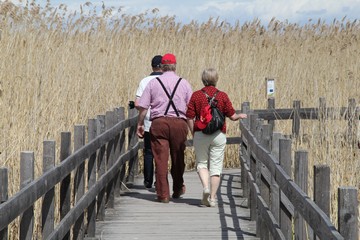 naturum Tåkern - in the reed sea
naturum Tåkern - in the reed sea
1. naturum Tåkern, visitors' zone Glänås
On the south side of the lake lies its largest visitors' zone. Naturum Tåkern has an imaginative exhibition about the nature of the lake, cinema,
laboratory and souvenir shop. The guides of naturum are friendly, competent and inspiring. Between the trees there
is a long ramp for disabled people and wheelchair users up to the watchtower. From here you can observe the bird
life on the lake, but especially on the islands in the shore area where black-headed gulls breed.
A four-kilometre-long hiking trail provides good opportunities to get to know Tåkern. The trail goes through beach forest and over beach meadows. A footbridge through the reeds leads a bit out into the reed sea. Along the trail there are a couple of small hides, a bird tower and Arknat's windbreak ‘Re-ed’. The shelter is perfect for birdwatchers who want to get up a bit or for those who want to have a cup of coffee in the reeds.
A detour leads to Svanshals church and Svanshals former parish house/hostel. 600 metres of the reed path are wheelchair-friendly, as is the 700-metre-long beach promenade.
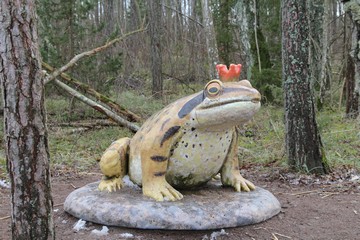 Prinsessan Estelles sagostig
Prinsessan Estelles sagostig
2. Princess Estelle's Sago trail
Follow the rabbit Ann-Sofie looking for her buddy Hasse.
The fairy tale trail starts directly at the entrance to naturum Tåkern and leads over
700 m through the riverbank forest, past orchids, the open water and the reeds. On the tour you will meet
different forest inhabitants. Crawl, climb, listen, smell. But where is Hasse?
The fairy-tale trail at Tåkern is a christening task for Princess Estelle, Duchess of Östergötland. The governor Elisabeth Nilsson handed over the gift for baptism in spring 2012, and Princess Estelle inaugurated the path on 17 May 2014.
Tåkern's Nature playground
At the car park at the nature centre is Tåkern's Nature playground, where you can balance, climb and swing along a track.
You can play here for hours!
There are barbecue areas and picnic tables nearby. It is also close to the toilets and if you follow the path under the portal you will reach the nature centre.
There is no scheduled service to Tåkern. But at Östgötatrafiken you can book journeys between Vadstena and northern part of Tåkern (Väversunda, Svälinge, Hov) as well as between Ödeshög and southern Tåkern (naturum Tåkern, Svanshals). Read more on Östgötatrafiken - Närtrafik (In swedish only, use translation function for information in English).
3. Svanshals Parish House
The renovated old school from 1849 has most recently been home to Tåkern hostel. The building has eight rooms for
24 people and a sauna for 16 people and was last rented by the new owners as a holiday home, for weddings, parties,
conferences, etc. The house is offered for sale.
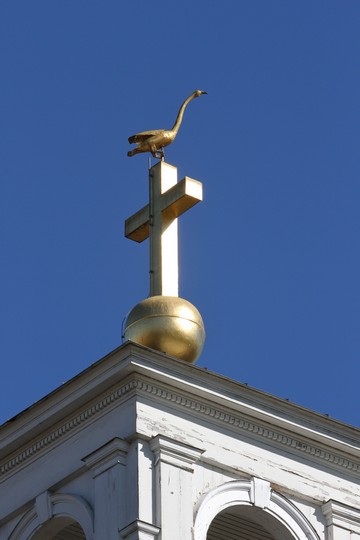 Svanshals Church
Svanshals Church
4. Svanshals' church
The municipality is named after the mute swan, the typical landscape bird of the Tåkern. In earlier years there
was a wooden church here, presumably built by the supreme judge Bengt Magnusson, an uncle of the Sancta Birgitta.
The oldest parts of today's church date from the 12th century. From this period the old limestone foundation and
parts of the tower have been kept.
5. Tåkerns fältstation
The Tåkerns Fältstation association has been
carrying out inventory and nature conservation in and around the Tåkern since 1963.
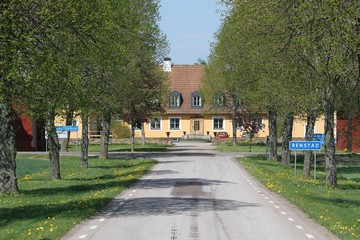 Renstad
Renstad
6. Renstad Gård
Renstad (formerly Rehnstad) has been known since the 17th century and consisted of a so-called Skatte- and a Biskopsgård.
The estate had two heydays. The last one was during Baron Axel Hermelin's days. At that time it was a real small village with school, shop, missionary house and dairy. The number of employees was 125.
By dewatering and draining the baron enlarged his estate after lowering the water level in the Tåkern by about 400 tunnland arable land. He let canals be built and operated mills and sawmills with hydroelectric power. He created a park and built most of the houses that still exist today. Hermelin's greatest dream, however, was to drain the Tåkern completely and turn it into a single farm. Luckily, it stayed with this dream.
 Rökstenen
Rökstenen
7. Rökstenen
Röksten is one of Sweden's most famous rune stones. His inscription with 760 characters is considered to be the
longest runic script in the world. The Röksten was probably erected in the first half of the 9th century.
8. Dags Mosse
The extensive moor between Tåkern and Omberg was originally a bay of Lake Tåkern. Peat is extracted here in an
ecological way. The moor is drained to the south through the Ålbäcken, which flows into the Vättern.
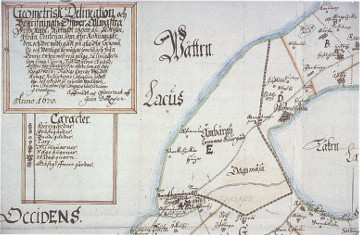 Map of Omberg's animal park
Map of Omberg's animal park
9. Holmen
In the first half of the 17th century, a state enclosure was built on the Omberg. It was surrounded by a
21-kilometre-long and about four-metre-high gärdesgård, which was maintained by the local farmers. The fence also
surrounded the Dags Mosse. At Holmen, one of five gates in the fence was located.
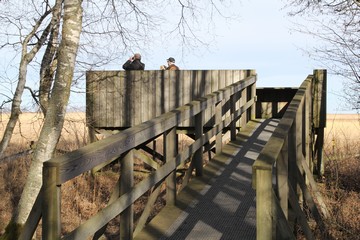 Väversunda observation platform
Väversunda observation platform
10. Väversunda visitors' zone
From the observation platform at Väversundamaden, you can gaze out over the largest continuous area of wet meadows
at Tåkern. During the spring, the lapwing, redshank, and snipe call across the meadows. In May, the greylag
geese tend to their young here and during mild nights, the spotted crake can be heard. Beyond the wet meadows, a
substantial area of reeds begins.
The wet meadows are kept open by pasturage and haymaking. Whereas in the past grass and sedge were cut by scythe, today tractor-pulled mowers are used.
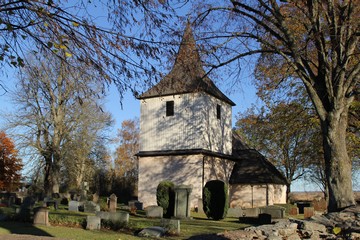 Väversunda church
Väversunda church
11. Väversunda church
A Romanesque and best-preserved medieval church from about 1160, built of Ombergs limestone. The predecessor
was probably a stave church.
For guided tours of Väversunda church and the Berzelius exhibition (below) see here: Kulturguidningar i Dal.
12. Berzeliusgården
Birthplace of Jöns Jacob Berzelius (1779-1848)
, chemist and natural scientist, discoverer of the chemical elements cerium, selenium, silicon and
torium.
The
Berzelius exhibition in Väversunda Church's porch has been moved to the parish hall and supplemented
with artefacts from Fenomenmagasinet in Linköping. The exhibition is open daily from 9 am to 6 pm during the summer
(as the church) and at other times.
13. Ostmossen's nature reserve
The nature reserve consists of a mosaic of different nature forms such as lime moor, wet meadows, dry limestone
meadows, open pastures as well as deciduous and coniferous forests, often with a marshy character. The flora is
rich. About ten species of orchids can be found, as well as a lot of other plants that require a calcareous
environment. In addition, Ostmossen with the nearby Ombergsliden forms one of Sweden's most distinguished places
of residence for large butterflies. Almost 300 different species were counted here. That is one third of all
butterfly species in Sweden.
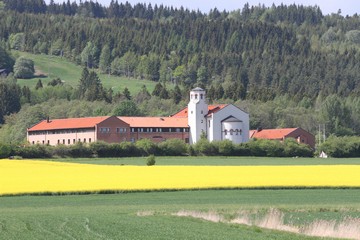 Hl. Hjärtas Kloster
Hl. Hjärtas Kloster
14. Hl. Hjärtas Kloster (Convent of the Sacred Heart)
The Convent of the Sacred Heart is located on a beautiful natural slope on the Omberg hill, which was inaugurated
in 1997. Here the sisters live a monastic life according to the rules of St. Benedict with the Virgin Mary as mother
and example.
15. Ombergsliden's nature reserve
Ombergsliden is mainly known for its rich orchids. Here one encounters species such as fly orchid, spotted orchid,
broad-leaved helleborine, marsh helleborine, listera ovata, early marsh-orchid and the rarely encountered gymnadenia
odoratissima. In the bogs of the nature reserve, which are rich in minerals, unusual snails such as the vertigo
geyeri can be found.
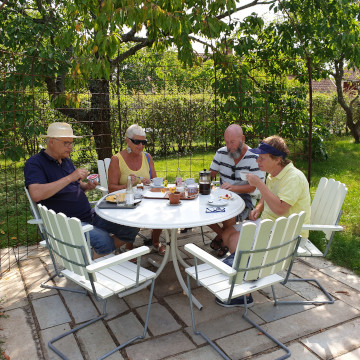 Kafé på Skedet
Kafé på Skedet
16. Kafé på Skedet
Kafé på Skedet is a popular summer café, famous for its pastries and bread, pub afternoons, so called "middagsklubben",
music entertainment and art exhibitions. Café is open Thursday-Sunday 11-17, pub Friday 17-22.
¨46-73-702 2097.
17. Rogslösa
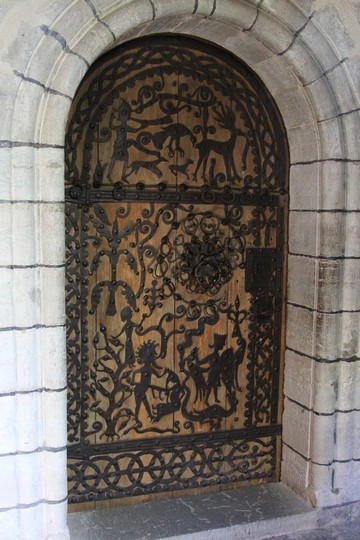 Rogslösa door
Rogslösa door
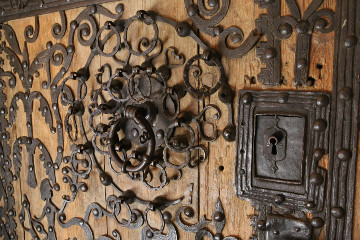 Rogslösa dorr, detail
Rogslösa dorr, detail
The church was built at the beginning of the 13th century as a private church of the only manor in Rogslösa and replaced a former wooden church. It is mainly known for its entrance portal with the so-called Rogslösa door.
Amongst others, Lydia Wahlström (1869-1954), an active member of the Swedish voting rights and women's movement, the majority of the "incomparable" sisters from Häckenäs and Jonas Andersson, a member of the parliament from Häckenäs, co-founder of Östgöta Dals and Östergötland's Volkshochschule, are buried in the cemetery.
With the construction of the railway Vadstena-Ödeshög a settlement developed around the railway station. Rogslösa was the seat of the former Östgöta Dals rural community.
For guided tours of Rogslösa church and cemetery see Kulturguidningar i Dal.
18. Källstad's church
The church of Källstad on the plain near the Tåkern still has its medieval church tower, but was rebuilt in 1868-69.
The original church and tower were built in the 12th century on private initiative. Due to its good acoustics,
Källstad's Church is well suited for concerts.
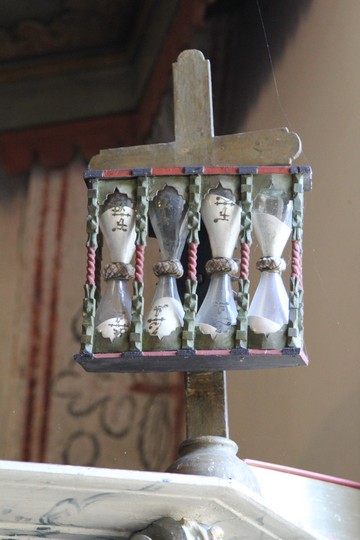 Interior in Herrestad' church
Interior in Herrestad' church
19. Herrestad's church
Herrestad was mentioned in writing as a medieval village as early as 1208. The first church at this place was
probably built of wood. In 1112 the present building of the church was built from limestone. Herrestad's Church
is the oldest church in Vadstena and Dal and one of the oldest church buildings in Sweden.
In the direct vicinity is Bischofs Kols Cellar, a so-called cellar house. His builder was supposed to be Bishop Kol from Linköping. The cellar was probably built in the 12th century by Bishop Lars. Originally, the stone cellar had a wooden superstructure and may have been used as a dwelling or storage building. The house is one of the few profane medieval rural houses in Östergötland.
Bishop Kol's cellar
Near the church is Bishop Kol's cellar, a so-called cellar cottage. The builder has been assumed to be Bishop Kol,
but the cellar was probably built by Bishop Lars in the 13th century. Originally, the stone cellar had a wooden
superstructure and may have served as a dwelling or storage room. The building is one of the few preserved secular
houses of medieval origin in the countryside of Östergötland.
A good and beautiful cycle path leads around the Tåkern, only side roads, no national roads. With the exception of a short stretch of road between Källstad and Herrestad and access to the naturum, all roads are asphalted. The national road is an asphalted alternative to the Källstad-Herrestad link.
20. Kolsbro
The old road to Linköping crossed the Mjölnaån at Kolsbro (Kols bridge). Kol, born in the first half of the 12th
century and died in Jerusalem in 1195 or 1196, had been a Swedish Catholic bishop of the diocese of Linköping since
1171 at the latest, and had the bridge built.
Kolsbro Häst & Fritid is a farm with a riding school for children and young people.
21. Svälinge visitors' zone
Here at the outlet of Tåkern into the Mjölnaån river, the first gap in the ice forms in the spring. From the
bird watching tower, you have a good view of the water birds that congregate there while waiting for
the ice to retreat from the remainder of the lake.
From the car park, a 900 metre long footpath leads to the bird watching tower. Along the footpath you can experience both wet meadows and stretches of forest. The wet meadows on both sides of the Mjölnaån river can be viewed from a small bird watching tower. During the autumn, the area is popular with cranes and geese.
In the forest along the hiking trail you will find Arknat's new windbreak "Solfjäder" ("hand fan").
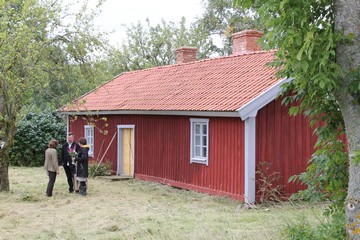 Broby Prästtorp
Broby Prästtorp
22. Broby prästtorp
Broby prästtorp is the name
of the old place of Prästgården in Broby next to the church grounds. The existing house was built after 1780 and
1810. By preserving and developing this place as a place of interest and meeting, its importance as a centre in
a now completely disappeared parish is emphasized as an important and as yet completely unknown part of the parish
in this area.
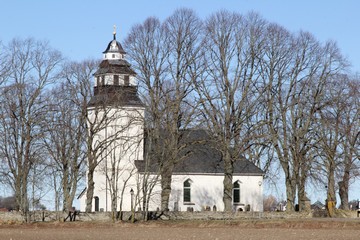 Church of Strå
Church of Strå
23. Church of Strå
The church of Strå, a few kilometres south of Vadstena and with a wide view over the plains and town, was
originally built in the 12th century and received its characteristic spire in 1771 from Mårten Beurling.
It has been rebuilt several times inside.
24. Hov's church
The church in Hov was built in the 12th century and is one of the oldest churches in the vicinity.
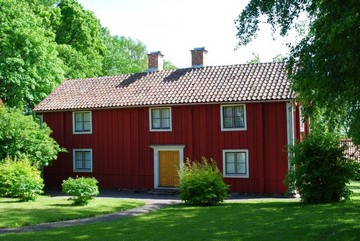 Skräddaregården 2010
Skräddaregården 2010
25. Skräddaregården (Hovs hembygdsgården)
With 15-20 farms, Hov belonged to the largest villages of Östergötland. Skräddaregården
is situated in its original place in the old village. The property is built with a so-called Parstuga from the
18th century, a brewery and a loge. Although the farm was inhabited until 1947, it has never been modernized.
It is therefore of great cultural value and was listed in 2009.
26. Hovgården
Hovgården is a former Kungsgård of Uppsala öd, i. e. a royal property from pre-Christian times and was the seat of
the Bailiff in Hovs län in the early Middle Ages.
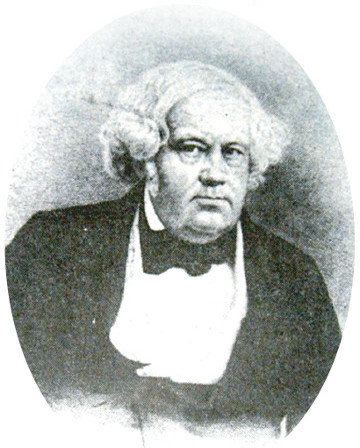 John Swartz (1790-1853)
John Swartz (1790-1853)
The manufacturer John Swartz (1770-1853) from Norrköping bought the Hovgården in 1834 as part of a larger investment in agriculture around Östergötland. Here he experimented with new crops and cultivation methods, introduced new techniques and ran target-oriented livestock breeding.
John Swartz became the main supporter and driving force of the great water level reduction project in the 1840s. However, the efforts on the Tåkern led to their worst results on the eastern side of the lake.
In the 1870s, sugar beet was grown on a larger scale in Hovgården. In 1871, one of the country's six sugar factories was established in Vadstena. Hovgården became their largest single supplier. However, the efforts ended in a fiasco. The profitability of the sugar factory was underestimated and the company went bankrupt in 1879. Two years earlier, Hovgården had to be sold for financial reasons and was divided into three parts.
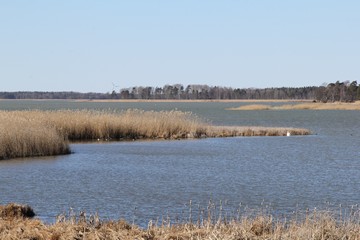 View from Hov's observation tower
View from Hov's observation tower
27. Hov's visitors' zone
From a sturdy bird watching tower, you have a good view of the most easterly part of Tåkern. The visitors’
area at Hov is a popular place for experiencing “the Big Take-Off” during the autumn. This is when all the geese
leave the lake at dawn to fly out to the fields to feed. The geese's return home together at dusk is also usually
a great experience. The Big Take-Off can be experienced from the end of September and thoughout the whole of October.
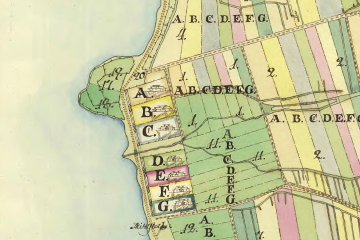 Furåsa, Field splitting (1764)
Furåsa, Field splitting (1764)
28. Furåsa
Furåsa is a village in a row, whose farms are still located in their original locations along the road after
the "Great" land reform and the legal land reform.
29. Väderstad Centralkonditori
Classic Swedish patisserie/bakery that has been in operation since 1914. They always serve freshly baked bread and
classic pastries with their own twist in an idyllic setting. Very popular destination for cyclists, motorcyclists
and many others.
30. Kumla church
The small romanesque limestone church was built at the end of the 12th century, but has undergone several
alterations since then, even though the medieval appearance has been preserved.
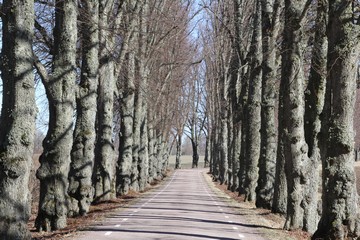 Alley near Kyleberg
Alley near Kyleberg
31. Kyleberg
Kyleberg (formerly Berga) is named after the governor Hans Kyle, who owned the farm in 1650. In 1850 Kyleberg
became the property of the politician Axel Dickson. He modernised the farm and made it one of the most advanced
in the country.
Dickson looked after the welfare of his workers, supported elementary schools and stood with his wife behind the Charlotte Dickson Foundation, which supported the education of poor girls. To finance his project, Dickson founded Wadstena Enskilda Bank, which had the right to issue its own banknotes. The bank finally collapsed due to embezzlement. Dickson lost his assets and relinquished the farm.
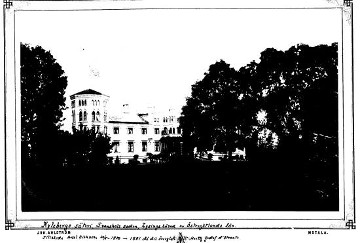 Kylebergs Säteri
Kylebergs Säteri
In 1953, the present main building replaced the former Corps de Logi, which had been demolished a few years earlier.
32. Särtshöga wineyard
Särtshöga Vingård, one of the northernmost vineyards in the world, is located in the middle of the beautiful
Östergötland plain with a view of Omberg. You are welcome to visit us during the summer months to stay at the small
estate hotel, participate in wine tasting and eat well.
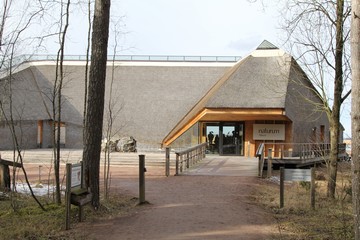 Naturum Tåkern
Naturum Tåkern
Naturum Tåkern is a modern tourist centre in Glänås on the southern shore of the bird lake Tåkern. The naturum is accessible to all.
In the naturum there is a creative exhibition, film room, laboratory and souvenir shop. The nature guides will be pleased to welcome you. They are efficient and inspiring. naturum offers a comprehensive, fixed programme throughout the year and also accepts bookings.
There is no café in the naturum, but you can buy a cup of coffee, tea or a glass of juice with snacks.
Opening hours 2025
25 January: 10:00-15:00
20-23 Februari (Winter school holidays): Daily 10:00-15:00
1 April – 31 August: Tuesday-Sunday 10:00-17:00
Open 21 April (Easter monday) 10:00-17:00
Programme Easter school holidays (15-21 April)
Closed Midsummer eve 20 June
1 September – 1 November: Thursday-Sunday 10:00-15:00
Entry
Naturum: Free entry
Landing nets Free entry
Binocular school in the bird tower: Free entry
Specific guided tours: Adults 60 kr
Lectures: Free entry
Contact
+46-144-53 51 55
Access route
Naturum Tåkern